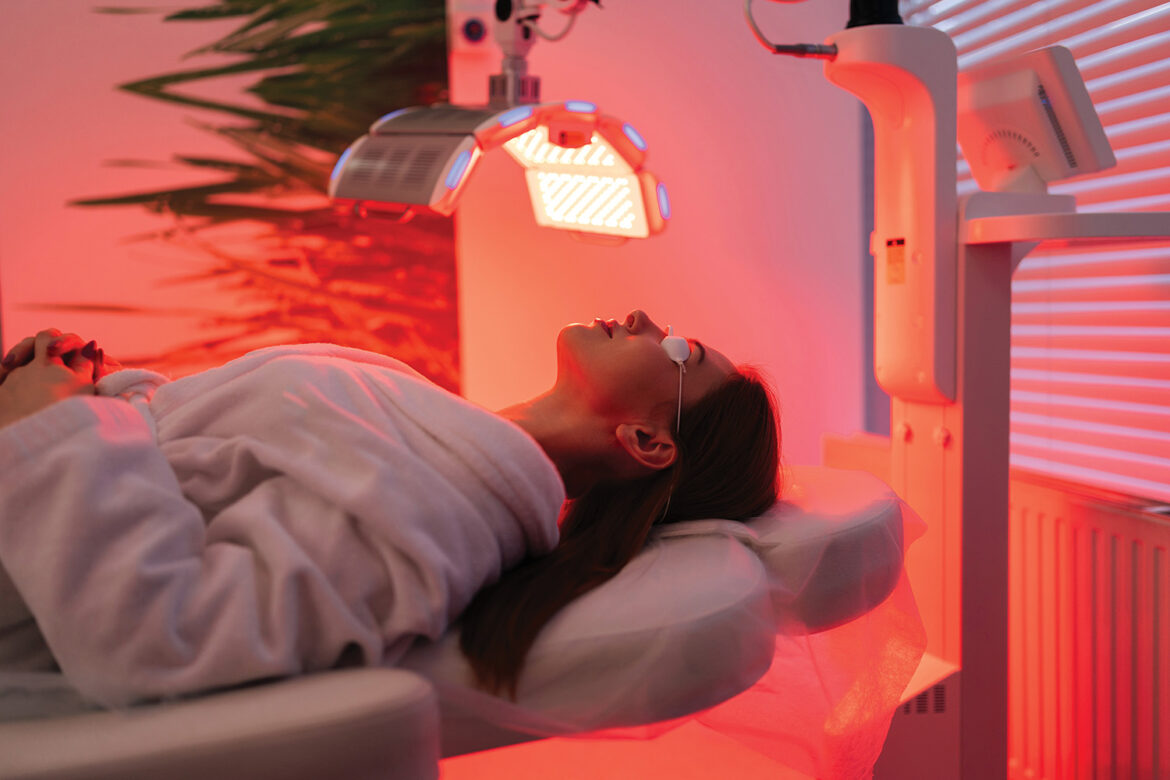892
There’s dunking yourself in cold water. There’s getting stuck with a bunch of tiny needles. There’s climbing naked into a chamber of liquid nitrogen. There’s succumbing to a deeply meditative state. There’s reiki, aromatherapy, sound “bathing,” massage; there’s good, ol’ fashioned cognitive talk therapy. The choices available to better ourselves are almost as plentiful as the problems that cause us to seek them.
And now … red light therapy. Thank goodness red light is getting the chance to better its reputation, having historically been associated with the unmentionable parts of town.
Also known as photobiomodulation, red light therapy is exposing your skin to varying wavelengths of red light. The higher wavelengths penetrate the deepest and warm our bodies from the inside, at a cellular level. When our cells are activated, they create energy (mitochondria) and that energy reinvigorates our cells for repair and top function. Et, voila.
Research and Reality
In the 1960s, an article in the Journal of Biophotonics details Hungarian physician Endre Mester’s research with red lasers on rats that led to hair growth and wound healing. In the 1990s, NASA experimented with light therapy in space for plant growth, and in 2002, the FDA (Federal Drug Administration) approved the first low-level laser therapy device for medical use. Lauren Colliver of Blacksburg’s Renew and Restore Wellness says red light therapy is what most clients come in for.
The most effective, sanctioned way to seek red light therapy for affiliated ailments is to visit a professional clinic. Chatting with a licensed therapist first about your specific concerns will assure a proper regimen to follow. The treatment can utilize devices that target specific areas, like a mask for your face or a wand for areas like an arthritic knee. Typically, though, red light is administered on a bed, like a tanning bed, for maximum full body exposure. Wall panels, varying in size, are also common.
Regimen
The panels at Renew and Restore Wellness are an FDA-approved medical device and hang above a cushioned table head-to-toe in length. They emit two wavelengths concurrently, 660 nanometers and 880 nanometers. The lower of the two wavelengths treats skin-level conditions such as acne, eczema, rashes, sunburn, wrinkles, psoriasis, poison ivy or scarring. The 880 level is near-infrared and penetrates deeper into the body, reaching that cellular, regenerative level. This benefits those suffering from muscle pain tension, chronic inflammation, arthritis, or even Lyme disease or long covid.
Sessions are generally 20 minutes with a halfway body flip. Clients undress to a point of comfort, understanding that the more skin exposed = better. Eye protector goggles are available.
“You’ll notice after 10 minutes that your muscles will just relax. If you have back pain and your muscles are tight and tense from guarding those areas, it really helps to relax those muscles for recovery,” Colliver states.
For that reason, athletes – professional and otherwise – prone to intense workout regimens utilize red light therapy to increase circulation and facilitate soft tissue repair. It is also credited with temporary weight loss or “body sculpting” (subtext: Key lifestyle changes still required for a more permanent transformation).
Like most therapies, it’s not a one-and-done solution, and it’s not curative, Colliver explains. The benefits build up over time. Frequent treatments are meant to help manage uncomfortable symptoms, and how often you go depends on the severity of the condition. While there are numerous at-home red light products, they don’t function at the same high wavelengths as those found in clinics; however, they can still be a handy, affordable solution. Colliver’s own son had a red light mask he used daily as a teenager to combat chronic acne.
Reality
Today, while light therapy’s popularity and availability is surging, it’s still fair to say it’s considered non-conventional. Advances in exactly what it can help, like chemotherapy side effects, dementia, hair loss and sleep disorders, are still in diligent research mode.
In 2020, the Jeffery Lab at University College London Institute of Ophthalmology conducted a study in exposing the human eyeball to 670 nanometers of red light for three minutes a week, within the first three minutes of waking up. The results showed a 17-20% improvement in visual acuity, or sharpness, but only in those 40 years of age or older – precisely the age group that stands to benefit the most from increased sharpness.
Once again, red light’s reputation is shifting, from hippy-dippy to legit, from raunchy to restorative. For that reason, it’s recommended to refrain from calling up and asking for the “red light special.” That therapy is best administered as an at-home treatment.
Text by Nancy S. Moseley
Nancy S. Moseley is a freelance writer who was graciously gifted a free red light sesh for article research. She’ll always happily sign up for any therapy that lets her close her eyes for a sustained period of time in a dark room with no one else around. And if it warms away’s life wrinkles, bonus.

